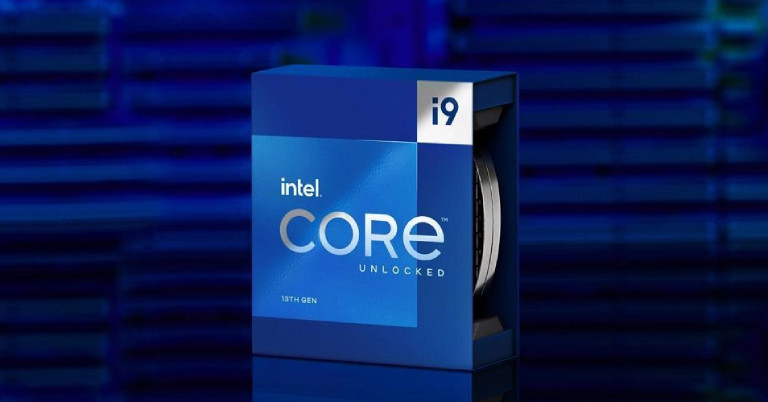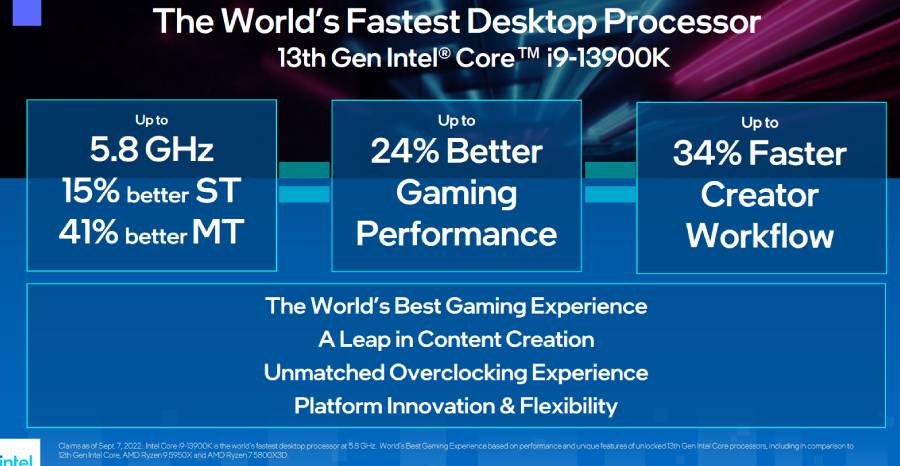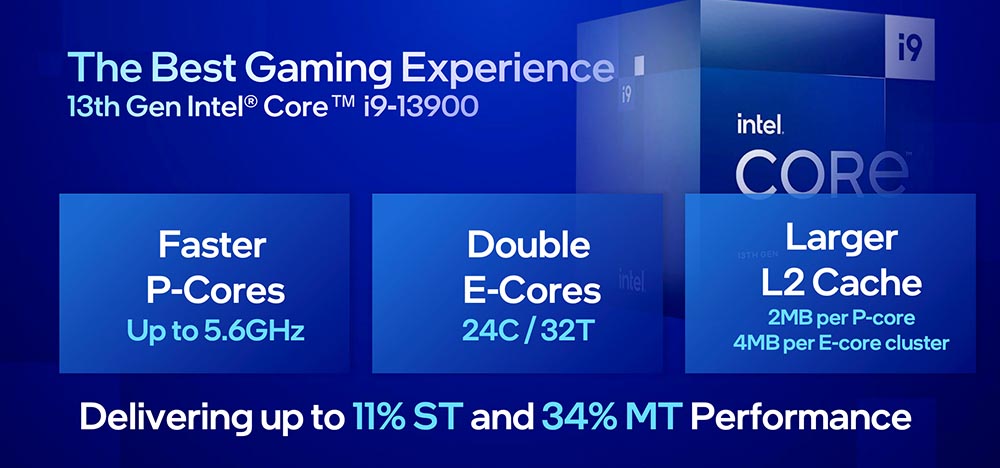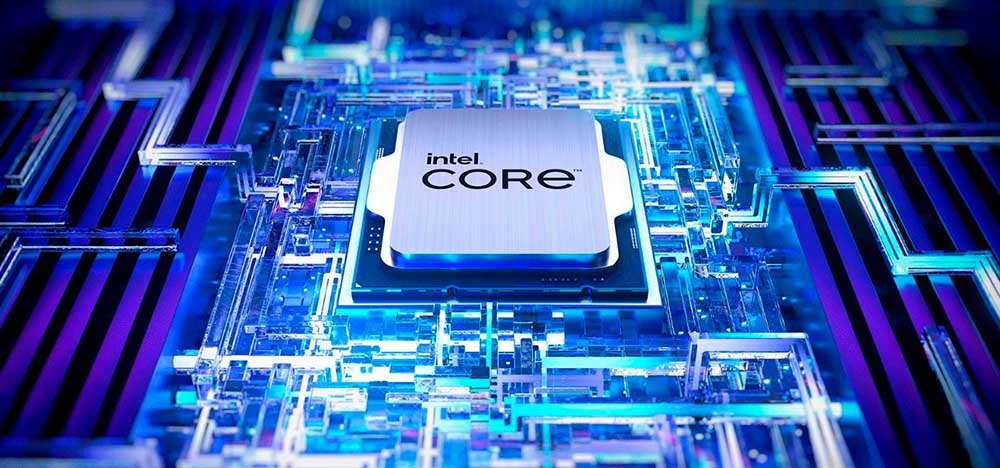
Intel officially unveiled its 13th Gen desktop processor lineup codenamed “Raptor Lake” back in September 2022. The news followed AMD’s announcement of the Ryzen 7000 series processors. While Intel initially launched six high-end SKUs in this lineup (with a base power of 125W), the company has finally unveiled 65W and 35W 13th Gen desktop processors at the ongoing CES 2023. So let’s take a look at the specifications, features, availability, and price of the Intel 13th Gen Raptor Lake CPU in Nepal.
Intel 13th Gen Raptor Lake CPU Overview:
The new 13th generation Raptor Lake CPUs retain Intel’s hybrid design of P (Performance) and E (Efficiency) cores, which were first introduced with the 12th Gen Alder Lake processors. Similar to last year, the company initially announced its “K” and “KF” processor SKUs.
As always, silicons with the “K” suffix are unlocked and can be overclocked to gain a little extra performance. And the “F” suffix in these CPUs indicates that they lack an integrated GPU. Let’s get into the specifics of the new Raptor Lake chips now.
125W Raptor Lake processors:
1. Core i9
The top-of-the-line Core i9-13900K/KF processor has 8 P-cores and 16 E-cores for a total of 32 threads. The performance cores can now reach up to 5.8 GHz boost clock speed, up from 5.1 GHz on the Core i9-12900K. Similarly, the E-cores have a boost clock speed of 4.3 GHz, up from 3.9 GHz in the previous generation.

In terms of performance comparison with AMD desktop processors, Intel hasn’t compared it to the Ryzen 7000 series CPUs in the launch event. Instead, Team Blue compared it to the AMD Ryzen 5000 series.
Intel claims that the Core i9-13900K outperforms the Ryzen 9 5950X in content creation tests such as PugetBench for Photoshop and PugetBench for Premiere Pro by 33% and 16%, respectively. While gaming, the Core i9-13900K is said to provide a 25% performance boost over the Ryzen 9 5950X. Aside from that, its base TDP is 125W, but with an adequate cooling solution, the rated maximum power draw at boost speeds is 253W.
2. Core i7, Core i5
Moving on, the i7-13700K/KF has eight P-cores and eight E-cores, for a total thread count of 24. It has an L2 cache of 24MB and an L3 cache of 30MB. The CPU can boost the P-cores to 5.4 GHz and the E-cores to 4.2 GHz. Surprisingly, it has the same base power of 125W and max Turbo power of 253W as the Core i9-13900K.
Last but not least, Intel unveiled the Core i5-13600K/KF CPU, which features six P-cores and eight E-cores. It has 44MB of total cache (24MB L2 + 20MB L3) and a maximum clock speed of 5.1 GHz.

All the new Intel 13th Gen Raptor Lake CPUs have one thing in common: they have twice the number of E-cores as their predecessors. Aside from that, all six CPU models have 20 PCIe lanes (up to 16 PCIe 5.0 + 4 PCIe 4.0), as well as support for DDR5-5600 and DDR4-3200 memory, with faster memory supported via XMP. The Intel UHD Graphics 770 is standard on all non-F SKUs.
Z790 Chipset
In addition, Intel announced the Z790 motherboard for Raptor Lake desktop CPUs. The new motherboard includes eight additional PCIe 4.0 lanes, increased USB 3.2 Gen 2×2 (20Gbps) ports, and DMI Gen 4.0 for faster peripheral and networking access. Users will also be able to use existing 600-series motherboards with 13th-generation chips as well.
Intel 13th Gen Raptor Lake (125W) CPU Specifications:
| CPU | Cores (P+E) | Threads | Base Clock (GHz) | Boost Clock (GHz) | L2 Cache | L3 Cache | Base Power | Max Power | RCP |
| i9-13900K | 24 (8+16) | 32 | 2.2 (E) | 4.3 (E) | 32MB | 36MB | 125W | 253W | $589 |
| 3.0 (P) | 5.8 (P) | ||||||||
| i7-13700K | 16 (8+8) | 24 | 2.5 (E) | 4.2 (E) | 24MB | 30MB | 125W | 253W | $409 |
| 3.4 (P) | 5.4 (P) | ||||||||
| i5-13600K | 14 (6+8) | 20 | 2.6 (E) | 3.9 (E) | 20MB | 24MB | 125W | 181W | $319 |
| 3.5 (P) | 5.1 (P) |
65W Raptor Lake processors:
Targeting the budget and mid-range gaming market, Intel has announced a total of 10 SKUs under the 65W category. Unlike the more powerful 125W processors in this lineup, these cannot be officially overclocked (although there may be some unofficial workarounds). Anyway, you’ll also find “F” and non-F SKUs under this lineup, indicating one with and one without integrated graphics, respectively.
1. Core i9
Leading the pack is the Core i9-13900/F. It has the same core configuration as the 13900K/KF (with 8 P-cores and 16 E-cores for a total of 32 threads) and the same cache size as well (32MB L2 + 36MB L3). But to make room for all of that in a lower thermal headroom, Intel has significantly underclocked these processors. Especially in terms of the base frequency. As a result, both these CPUs have just 1.5 GHz (E-cores) and 2 GHz (P-cores) base frequencies compared to 2.2 GHz and 3.0 GHz on their unlocked counterparts.

Memory compatibility remains the same, with Intel supporting both DDR5 and DDR4 RAM on these CPUs; unlike AMD’s Ryzen 7000 series that go all in on the newer but pricier DDR5 standard. While the Intel Core i9-13900/F have a base power of 65W, they are rated to draw up to 219W power. As for performance benchmarks, Intel claims “up to 11% faster mainstream application performance” on these 13th Gen i9 CPUs over last year’s Core i9-12900.
Thanks to the higher cores/threads count and a more mature Intel 7 process, the company also says these processors achieve up to 11% higher single-threading and 34% higher multi-threading performance while using the same power as i9-12900. And in terms of gaming, Intel’s official testing reveals 19% better results in League of Legends, 16% on Marvel’s Spider-Man Remastered, 15% on F1 22, and 6% on Guardians of the Galaxy.
2. Core i7
Moving down the ladder to Core i7, you have Core i7-13700 and i7-13700F. Compared to their 12th Gen predecessors, Intel is offering a higher boost frequency of up to 5.2 GHz, more E-cores, and a larger L2 cache here.
Likewise, these CPUs mimic their Core i9 brothers in terms of memory compatibility, memory capacity, and power consumption. On the other hand, they have lower core and thread counts (8 P-cores, 8 E-cores = 24 threads), and smaller L2 and L3 caches. The max turbo frequency on the 13th Gen 65W Core i7 CPUs also comes down to 4.1 GHz for E-cores and 5.2 GHz for P-cores.
3. Core i5
Finally, there are six different 65W Raptor Lake processors under the Core i5 lineup. Ranging from quad-core i3-13100/F with either 58W or 60W of base power, to the Core i5-13600 with 14 cores, alongside 65W base and 154W turbo power. Besides their lower cores/threads count and everything else, one crucial factor separating these from the Core i7 or Core i9 series is memory speed. While the i5 processors have a peak memory speed of DDR5-4800 or DDR4-3200, the Core i7 and Core i9 max out at DDR5-5600 or DDR4-3200.

Intel 13th Gen Raptor Lake (65W) CPU Specifications:
| CPU | Cores (P+E) | Threads | Base Clock (GHz) | Boost Clock (GHz) | L2 Cache | L3 Cache | Base Power | Max Power | RCP |
| i9-13900 | 24 (8+16) | 32 | 1.5 (E) | 4.2 (E) | 32MB | 36MB | 65W | 219W | $549 |
| 2.0 (P) | 5.6 (P) | ||||||||
| i7-13700 | 16 (8+8) | 24 | 1.5 (E) | 4.1 (E) | 24MB | 30MB | 65W | 219W | $384 |
| 2.1 (P) | 5.2 (P) | ||||||||
| i5-13600 | 14 (6+8) | 20 | 2.0 (E) | 3.7 (E) | 11.5MB | 24MB | 65W | 154W | $255 |
| 2.7 (P) | 5.0 (E) | ||||||||
| i5-13500 | 14 (6+8) | 20 | 1.8 (E) | 3.5 (E) | 11.5MB | 24MB | 65W | 154W | $232 |
| 2.5 (P) | 4.8 (P) | ||||||||
| i5-13400/F | 10 (6+4) | 16 | 1.8 (E) | 3.3 (E) | 9.5MB | 20MB | 65W | 148W | $221 / $196 |
| 2.5 (P) | 4.6 (P) | ||||||||
| i3-13100 | 4 (4+0) | 8 | n/a | 5MB | 12MB | 60W | 89W | $134 | |
| 3.4 (P) | 4.5 (P) | ||||||||
| i3-13100F | 4 (4+0) | 8 | n/a | 5MB | 12MB | 58W | 89W | $109 | |
| 3.4 (P) | 4.5 (P) | ||||||||
35W Raptor Lake processors:
Moving on, the Intel 13th Gen 35W T-series processors also see a healthy upgrade over their Alder Lake precursor. Mostly in terms of the number of cores/threads. There are six SKUs in this series, all with integrated graphics (Intel UHD Graphics 770) and 35W base power. The high-end i9-13900T has been configured with 24 cores (8 P, 16 E) and up to 106W power rating. Like the 65W Raptor Lake CPUs, Intel has set the same memory peak speed across the T-series as well. Sadly, the company hasn’t shared any performance benchmarks for these processors for now.
| CPU | Cores (P+E) | Threads | Base Clock (GHz) | Boost Clock (GHz) | L2 Cache | L3 Cache | Base Power | Max Power | RCP |
| i9-13900T | 24 (8+16) | 32 | 0.8 (E) | 3.9 (E) | 32MB | 36MB | 35W | 106W | $549 |
| 1.1 (P) | 5.3 (P) | ||||||||
| i7-13700T | 16 (8+8) | 24 | 1.0 (E) | 3.6 (E) | 24MB | 30MB | 35W | 106W | $384 |
| 1.4 (P) | 4.9 (P) | ||||||||
| i5-13600T | 14 (6+8) | 20 | 1.3 (E) | 3.4 (E) | 11.5MB | 24MB | 35W | 92W | $255 |
| 1.8 (P) | 4.8 (P) | ||||||||
| i5-13500T | 14 (6+8) | 20 | 1.2 (E) | 3.2 (E) | 11.5MB | 24MB | 35W | 92W | $232 |
| 1.6 (P) | 4.6 (P) | ||||||||
| i5-13400T | 10 (6+4) | 16 | 1.0 (E) | 3.0 (E) | 9.5MB | 20MB | 35W | 82W | $221 |
| 1.3 (P) | 4.4 (P) | ||||||||
| i3-13100T | 4 (4+0) | 8 | n/a | 5MB | 12MB | 35W | 69W | $134 | |
| 2.5 (P) | 4.2 (P) | ||||||||
B760 Chipset
To go with the affordable 65W and 35W processors, Intel also unveiled the B760 chipset. It supports a single PCIe 5.0 x16 graphics interface, whereas DMI (Direct Media Interface) lane has also been reduced from Z790’s x8 to x4 here. It also supports two USB 3.2 Gen 2 x2, four USB 3.2 Gen 2, and six USB 3.2 Gen 1 ports.
Intel 13th Gen “Raptor Lake” CPU Price in Nepal and Availability
The price of the 13th Gen Intel “Raptor Lake” desktop processor ranges from Rs. 20,000 to Rs. 85,000. Intel Core i3-13100F is the most affordable option of the bunch whereas the i9-13900KS is the most premium. You can buy these desktop processors from Hukut.
| 13th Gen “Raptor Lake” CPUs | Price in Nepal | |
| Core i9 | i9-13900KS | Rs. 85,000 |
| i9-13900K | Rs. 80,000 | |
| Core i7 | i7-13700K | Rs. 60,000 |
| Core i5 | i5-13600K | Rs. 45,000 |
| i5-13400 | Rs. 30,000 | |
| Core i3 | i3-13100 | Rs. 22,000 |
| i3-13100F | Rs. 20,000 | |
- Meanwhile, check out our comparison of Intel Core i7-12700K vs i7-11700K.







![Best Gaming Laptops in Nepal Under Rs. 200,000 (रु 2 Lakhs) [2025] Best gaming lapotp under 2 lakhs Nepal Feb 2025](https://cdn.gadgetbytenepal.com/wp-content/uploads/2025/01/Best-Gaming-Laptops-Under-2-Lakh-Nepal-Feb-2025-Update.jpg)
![Best Gaming Laptops in Nepal Under Rs. 120,000 (रु 1.2 Lakhs) [2025] Best Budget Gaming Laptops Under Rs 120000 in Nepal 2025 Update](https://cdn.gadgetbytenepal.com/wp-content/uploads/2025/05/Best-Budget-Gaming-Laptops-Under-Rs-120000-in-Nepal-2024-Update.jpg)
![Best Gaming Laptops in Nepal Under Rs. 150,000 (रु 1.5 Lakhs) [2025] Best gaming laptops under 150k November 2024](https://cdn.gadgetbytenepal.com/wp-content/uploads/2024/11/Best-gaming-laptops-under-150k-November-2024.jpg)

![Best Laptops Under Rs. 80,000 in Nepal [2025] Best Laptops Under 80,000 in Nepal March 2025 Update](https://cdn.gadgetbytenepal.com/wp-content/uploads/2025/03/Best-Laptops-Under-80000-in-Nepal-March-2025-Update.jpg)
![Best Mobile Phones Under Rs. 15,000 in Nepal [Updated 2025] Best Phones Under 15000 in Nepal 2024 Budget Smartphones Cheap Affordable](https://cdn.gadgetbytenepal.com/wp-content/uploads/2024/03/Best-Phones-Under-15000-in-Nepal-2024.jpg)
![Best Mobile Phones Under Rs. 20,000 in Nepal [Updated] Best Mobile Phones Under NPR 20000 in Nepal 2023 Updated Samsung Xiaomi Redmi POCO Realme Narzo Benco](https://cdn.gadgetbytenepal.com/wp-content/uploads/2024/01/Best-Phones-Under-20000-in-Nepal-2024.jpg)
![Best Mobile Phones Under Rs. 30,000 in Nepal [Updated 2025] Best Phones Under 30000 in Nepal](https://cdn.gadgetbytenepal.com/wp-content/uploads/2025/01/Best-Phones-Under-30000-in-Nepal.jpg)
![Best Mobile Phones Under Rs. 40,000 in Nepal [Updated 2025] Best Phones Under 40000 in Nepal 2025](https://cdn.gadgetbytenepal.com/wp-content/uploads/2025/07/Best-Phones-Under-40000-in-Nepal-2025.jpg)
![Best Mobile Phones Under Rs. 50,000 in Nepal [Updated 2025] Best Phones Under 50000 in Nepal](https://cdn.gadgetbytenepal.com/wp-content/uploads/2025/01/Best-Phones-Under-50000-in-Nepal.jpg)
![Best Flagship Smartphones To Buy In Nepal [Updated] Best smartphones to buy in Nepal 2025 flagship phones](https://cdn.gadgetbytenepal.com/wp-content/uploads/2024/05/Best-Flagship-Phones-who-is-it-ft.jpg)